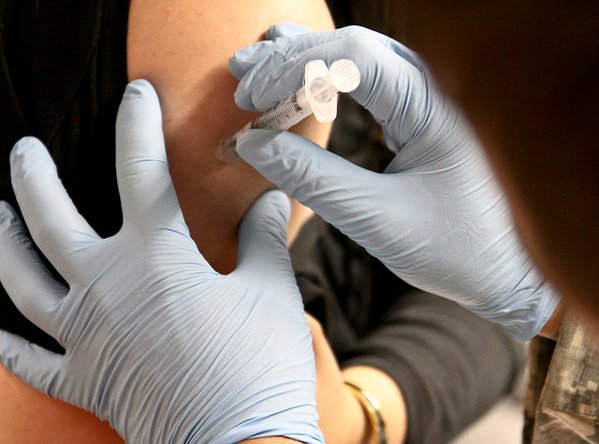Early estimates show low flu vaccine effectiveness in US

Early estimates published by the CDC today show that the influenza vaccine has been only 36% effective overall in the United States this season, and only 25% effective against the predominant circulating strain.
The results mirror estimates from other countries, including Australia and Canada, showing that this season’s vaccine has not offered much protection.
“These early [vaccine effectiveness (VE)] estimates underscore the need for ongoing influenza prevention and treatment measures,” Brendan Flannery, PhD, epidemiologist in the CDC’s Influenza Division, and colleagues wrote in MMWR. “CDC continues to recommend influenza vaccination because the vaccine can still prevent some infections with currently circulating influenza viruses, which are expected to continue circulating for several weeks.”
Since 2004, the CDC has estimated VE based on children and adults who are enrolled in the U.S. Influenza VE Network at five study sites across the country. Researchers measure the vaccine’s ability to prevent outpatient medical visits due to laboratory-confirmed influenza infections.
According to Flannery and colleagues, among 4,562 children and adults with acute respiratory illness (ARI) who enrolled at the five study sites from Nov. 2 through Feb. 3, 38% tested positive for influenza. Most — 67% — had H3N2, an influenza A virus that is known to evade the vaccine and cause relatively severe illness. H3N2 has remained the predominant strain in the U.S., which usually portends a severe influenza season.

In a widely anticipated finding, despite no definitive evidence of antigenic drift in the strain, the CDC estimated that the vaccine has been just 25% effective against H3N2 in the U.S. this season, although not all groups were similarly protected. Flannery and colleagues said the vaccine has been 59% effective in children aged 6 months to 8 years. According to the researchers, multiple factors may explain why the vaccine is historically less protective against H3N2, including age-related differences in immune response and genetic changes that occur from growing the vaccine in eggs.
Flannery and colleagues reported that the vaccine has provided “substantial protection” against influenza A(H1N1) (67%) and “moderate protection” against influenza B viruses (42%).
If it holds, the estimated overall adjusted VE of 36% this season would be the second-worst since 2006-2007. In 2014-2015, a recent benchmark for bad influenza seasons, the vaccine was estimated to be just 19% effective.
The first indication that season’s influenza vaccine would be underwhelming came just as the season was starting in the Northern Hemisphere. Australia reported an estimated overall VE of 33%, including just 10% against H3N2. Earlier this month, researchers reported that the vaccine had been 42% effective overall in Canada but only 17% effective against H3N2, a result that surprised some experts.

The U.S. estimate of VE against H3N2 is higher, but in reality, the results from all three countries are similar, according to Michael T. Osterholm, PhD, MPH, director of the Center for Infectious Disease Research and Policy at the University of Minnesota.
“If you look at the confidence intervals, they all overlap. The results are very similar,” Osterholm told Infectious Disease News. “There’s nothing here that’s surprising. It’s very consistent with what we’ve been seeing.”
Also today, four U.S. senators called for $1 billion in government funding to develop a universal influenza vaccine that could provide longer lasting protection compared with seasonal vaccines. Senators Richard Blumenthal (D-Conn.), Angus King (I-Maine), Amy Klobuchar (D-Minn.) and Edward J. Markey (D-Mass.) said there is an urgent need for a vaccine that can be administered once or twice and provide a lifetime of protection.
The CDC said last week that the influenza season in the U.S. was on track to break some recent records. One key marker — the percentage of outpatient and emergency clinic visits attributed to influenza-like illness — has reached the peak level of the 2009 pandemic. But other indicators of a severe influenza season, including the number of pediatric deaths, remain lower than in recent years, Osterholm said.
“I think one of the challenges we have is understanding what is the severity of the virus and what is the lack of preparedness of our health care system to deal with it,” Osterholm said. “People have painted this as the worst flu in recent memory, and it’s probably not good. Any death from influenza is an unfortunate tragedy, but at this point, it’s hard-pressed to say that this is a significantly elevated year for influenza. It’s more of a media issue than an actual data issue.”
The CDC will release updated surveillance data on Friday. – by Gerard Gallagher
Reference:
Flannery B, et al. MMWR Morb Mortal Wkly Rep. 2018;doi:10.15585/mmwr.mm6706a2.
Disclosures: The authors report no relevant financial disclosures. Osterholm reports no relevant financial disclosures.
